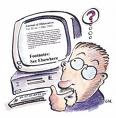
arthur@glazerthepctech.com
Let's talk drivers. There are those that take us places, some that hit balls, and some are drivers for screws.
But there are also drivers for computers. They are device drivers: small programs, the catalysts that allow components to run on our computers. Without them, things like printers, video or sound cards, to name a few, would not work.
They run quietly in the background, never commanding our attention until something goes wrong.
There are dozens of these drivers on our computers. Sometimes they get corrupted or lost. Updating and backing them up are yet more tasks on the list of computer maintenance to-dos.
When your system crashes or when you suddenly discover you can't hear iTunes or you lose the ability to print, it's time to take a look at your device drivers. When you reinstall Windows, there are usually things that don't work properly, including sound and Internet. The display on your monitor may work, but it may look different. This is all due to drivers or the lack thereof.
When you purchase a printer, video card or whatever, a disk is usually included in the package. That's your driver. After their initial installation, we tend to misplace them, never to be seen again.
Windows, being the selfish operating system that it is, only comes with enough drivers for itself. The rest is up to us. Since everyone has different printers, different video cards and all sorts of other unique devices, Microsoft chose not to include those drivers with Windows. All that will change with Vista's successor.
So for now, we have the option of scouring the manufacturer's Web sites for the extraneous drivers, or getting a program to do it for us.
Some of these programs will find updates for you; some will back up your existing drivers as well. But some leave it up to you where to place them.
I like the ones that create a self-installing package for use after the inevitable operating system crash. They update the drivers, back-up everything and create an auto-installer. All you need to do is click on it and the drivers go where they need to go.
Let's start by looking at the drivers. In XP, right-click on My Computer and go to Properties then the Hardware tab. In there you'll see a Device Manager button. In Vista, click Start, then Control Panel, go to System and Maintenance, then to Device Manager. If the list you then see has any yellow exclamation marks or red x's, you have some device driver issues.
You'll see an option to Reinstall Driver in that box. If you click on it, it will ask you if you want to look through the file structure, where you'll need to know where to look, or to look on the Internet for the driver.
The thing is, if you don't have a driver for your Ethernet card, you won't have an Internet connection to find that driver. Joseph Heller would have loved this. You'll also have the option to roll back the driver to a previous one.
Let's say for now that you don't have a program to help you. If you do have a driver disk, put it in the drive and go to Device Manager. Ask it to reinstall a driver and make sure you have the box checked to search your CD drive. Hit Enter and wait. If it is the correct disk, all you need to do is follow the prompts and you're set.
If you do need to look on the Internet (you could always use another computer if you have to), go to the manufacturer's Web site and look under either support or downloads for drivers. Make sure you download the correct driver for your device and that it's for your operating system.
After you install it, be sure to reboot the system.
Even if your system is working properly, it doesn't hurt to check for updates occasionally. It could enhance your computer's performance. If you notice a device isn't working as it should, running slowly or otherwise malfunctioning, consider the driver. It could be corrupt.
Some programs worth checking out are Driver Max, at www.drivermax.com which is free, or Driver Detective at www.drivershq.com, a $30 program but worth the cost. Driver Genius is also a good program and although not free, you can try it for two weeks. You can find it at www.driver-soft.com.
Whether you're doing a driver backup because you need to, or just as a precautionary measure, it's always a good idea to archive them off of the computer. Burn them to a CD or put them on an external drive. You never know when you might need them.
The bottom line is that we could not do without our drivers, no matter what type they may be.
'Nuff said. Home, James.
Arthur Glazer is a freelance writer and computer technician in Gainesville. His column appears biweekly. Arthur welcomes your computer questions and ideas for future columns.

No comments:
Post a Comment
Got a Comment - or a quick question...